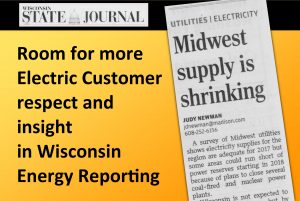Wisconsinites are hungry for news about energy– from “big picture” trends, to controversial transmission expansion to lagging assistance in making efficiency and renewable energy improvements to our homes, farms and businesses. Given this healthy appetite in the common good, it is disappointing when newspapers print under-analyzed utility press releases, as-is, on the front page. In interest of correctness and societal benefit, the following is a list of observations an alert writer can consider when attempting to make a utility-sourced press release into relevant news. It uses, as example, a recent article, “Midwest Supply is Shrinking” printed in the Wisconsin State Journal.
1. Foreground interests of Wisconsin electric customers. Foremost, Wisconsin electric customers face these realities: nation-leading fixed-fee increases, the midwest’s highest electric rates, profoundly lagging efficiency/renewable benefits and no progress in carbon emission reductions by state utilities. Useful energy reporting would help ratepayers untangle the lack of service we are experiencing and tie all new developments to these stubborn, historical challenges.
2. Consider potential bias. Bias in the cited report originates in self-surveys conducted by midwest utilities and analysis authored by MISO. MISO is an organization dominated by utility interests where 18 of 26 voting members represent for-profit utilities. MISO never suggests end-user investments which electric customers highly prefer. Counter-balance in a news story cannot be achieved by including one counter utterance. Wisconsin readers deserve developed arguments and positions. Ask all potential sources if they currently receive money from for-profit utilities or have in the past. Mention when possible influence of money exists.
3. Research rather than dumb-down the information. In this example, the MISO report does not address possible, overall energy shortages as the headline, “Midwest Supply is Shrinking” asserts. The report considers only the extra (reserve) power that might be available on peak use summer days under a crucial, hypothetical condition that is not even mentioned in the news story. That condition is: any, potential lack of preparedness under rare, peak, conditions is fully dependent on electricity use increasing at a rate we have not seen in many years. The MISO report admits that their prediction is, ”not in line with recent history of flat year-to-year loads.” The 2015 edition of the report used a growth rate of .8% per year. In a likely future where electricity use remains flat, midwest states would use 4% less electricity than MISO is predicting over the next 10 years. A curious reporter might wonder, What percentage of MISO’s total generation are utilities considering retiring? If we can avoid building new power plants and transmission by staying on track and not increasing demand by only 4%, what justifiable excuse is there for NOT staying on track?
4. Read the report and find details and omissions of interest to readers. In this case, the MISO report reveals that Wisconsin utilities have overbuilt power plant capacity compared to other states. An alert writer would quickly notice that the report ignores the rapid development being made in home, business and community solar. If a writer keeps up with user-side developments, he/she would also notice that the report ignores advances in load management allowing customers to profit from reducing peak load in their homes and apartments with smart phone apps.
5. Make utility interests more accountable, not less. In this case, the MISO report does not suggest– as the writer infers– that more power plants and transmission might be needed. Such false conclusions dis-serve electric customers. Electricity costs are spiraling upwards in Wisconsin because of excessive capital utility spending described by the WI Public Service Commission as our “extended spending cycle.” These dollars spent on unnecessary debt leave our state, whereas, investments in energy efficiency, local power and load management go directly to our local economies and jobs and save us money in the long run. They are also the most cost-effective, guaranteed, means of lowering carbon emissions,
6. Follow the money. Fixed fee hikes awarded to WI utilities since 2012 will cost electric customers around $12 billion for payments on capital debt on approved power plants and transmission lines. If WI newspaper writers had equally represented electric customer priorities over the last decade, electric customers could be enjoying the best energy efficiency, load management and solar program in the midwest with billions left in their pockets over coming years.

